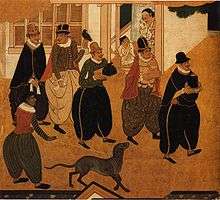Nanban art
Nanban art (南蛮美術) refers to Japanese art of the sixteenth and seventeenth centuries influenced by contact with the Nanban (南蛮) or 'Southern barbarians', traders and missionaries from Europe and specifically from Portugal. It is a Sino-Japanese word, Chinese Nánmán, originally referring to the peoples of South Asia and Southeast Asia. During the Nanban trade period, the word took on a new meaning when it came to designate the Portuguese, who first arrived in 1543, and later other Europeans. The term also refers to paintings Europeans brought to Japan.[1][2]
History
Nanban art developed after the first Portuguese ships arrived in Kyushu in 1543. While Christian icons and other objects were produced, Nanban byōbu (南蛮屏風) or folding screens are particularly notable, with between 60 and 80 pairs surviving to this day[1]. Another popular area within Nanban art was the depiction of foreign warriors. Artists of the Kanō school were joined by those of the Tosa school in combining foreign subject matter with Japanese styles of painting. Canons of western art of the period such as linear perspective and alternative materials and techniques appear to have had little lasting influence. The persecution and prohibition of Christianity from the end of the sixteenth century and the Tokugawa policy of sakoku that largely closed Japan to foreign contact from the 1630s saw the decline of Nanban art.[1][3]
Reverse influence
While Japonism did not develop in the west until after the reopening of Japan in the 1850s and the 1860s, there is evidence of earlier Japanese influence in the art of Colonial Mexico, as Japanese crafts were traded through the Manila Galleons from Manila (Philippines) to Acapulco (Mexico) from 1565 to 1815.[4]
Museums with collections of Nanban art
- Kobe City Museum[5]
- Museu Nacional de Arte Antiga[6]
- Museu do Oriente, Lisbon
See also
References
- 1 2 3 Okamoto, Yoshitomo (1972). The Namban Art of Japan. Weatherhill. ISBN 0-8348-1008-5.
- ↑ "Nanban-e". Japanese Architecture and Art Net Users System. Retrieved 28 March 2011.
- ↑ "Nanban-byoubu". Japanese Architecture and Art Net Users System. Retrieved 28 March 2011.
- ↑ Lake, Rodrigo Rivero (2006). Namban: Art in Viceregal Mexico. Turner. ISBN 978-84-7506-693-6.
- ↑ "Kobe City Museum e-guide" (PDF). Kobe City. Retrieved 28 March 2011.
- ↑ "Biombos Namban (Namban screens)". Museu Nacional de Arte Antiga. Archived from the original on 20 May 2011. Retrieved 28 March 2011.
| Wikimedia Commons has media related to Namban. |

